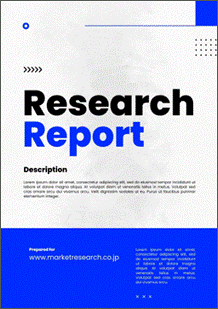 | • レポートコード:D0-MOR-AP1454 • 出版社/出版日:Mordor Intelligence / 2020年4月 • レポート形態:英文、PDF、150ページ • 納品方法:Eメール(受注後2-3営業日) • 産業分類:農業 |
| Single User | ¥555,000 (USD3,750) | ▷ お問い合わせ |
| Team User | ¥629,000 (USD4,250) | ▷ お問い合わせ |
| Corporate License | ¥1,036,000 (USD7,000) | ▷ お問い合わせ |
• お支払方法:銀行振込(納品後、ご請求書送付)
レポート概要
| 本調査レポートは、生体刺激剤のアジア市場について調査・分析した資料で、生体刺激剤の市場概要、動向、セグメント別市場規模、競争状況、企業情報、市場機会分析などで構成されています。 |
The biostimulants market by the Asia Pacific is predicted to rise with a CAGR of 15,2% during the forecast period 2020-2025. An increase in the demand for quality agricultural products, organic produces, and the increasing need for high productivity and yield is expected to increase the consumption of bio-stimulants in Asia-Pacific, especially in China, India, and Japan. These Asian countries demonstrate a high consumption rate for the products, given their competitive and growing agriculture sector. The regional market constitutes 20% of the global plant biostimulant market. The low toxicity levels and superior efficiency have instigated a speedy approval of the products. Therefore, unlimited opportunities are available in the Asia-Pacific market scenario for the implementation of biostimulants.
Key Market Trends
Growing Demand to Enhance Yield and Productivity
Agriculture is a critical sector for the livelihood of individuals and the stability of the overall global economy. Meeting the food needs and their productivity requirements in the future are of tremendous importance, because of the increasing global population. This can be achieved through a set of innovations and technologies that have recently come up in support of the agriculture sector; one among them is using biostimulants to boost agricultural production. The use of biostimulants results in improved plant productivity, as they help in the overall nutrient uptake of the plant, without affecting the environment. Plant biostimulants contain beneficial microorganisms, which when applied to the plant, enhance nutrient uptake, improve tolerance to abiotic stress, and overall crop growth. The growing concern on environmental health is anticipated to aid in the growth of the market studied, over the forecast period. Plant biostimulants are treated as an alternative to chemical intake in the agricultural lands.
China Dominates the Biostimulant Market in Asia-Pacific
China forms the largest market for plant biostimulants in Asia-Pacific, with a market share of 33.0%. The increasing population (particularly the middle-class consumers), growing interest in sustainability, and the popularity of organic farming have created an attractive market for plant biostimulants in the country. China is a leader in terms of the development and deployment of biostimulants, especially since the country is the largest national consumer of fertilizers. Around 13.0% of the plant biostimulant market in China is occupied by protein hydrolysates, and the segment is expected to record faster growth during the forecast period.
Competitive Landscape
The Asia Pacific biostimulant market is highly fragmented, with various small and medium-sized companies and a few big players, resulting in stiff competition in the market. The development of regional markets and local players in different parts of the world is the major factor for the fragmented nature of the market. North America and Europe are the two regions showing maximum competitor activities where as major players like Valagro, Biostimulant , BASF AG are the dominant player in Asia-Pacific Market.
Reasons to Purchase this report:
– The market estimate (ME) sheet in Excel format
– 3 months of analyst support
1 INTRODUCTION
1.1 Study Deliverables
1.2 Study Assumptions
1.3 Scope of the Study
2 RESEARCH METHODOLOGY
3 EXECUTIVE SUMMARY
4 MARKET DYNAMICS
4.1 Market Overview
4.2 Market Drivers
4.3 Market Restraints
4.4 Porter’s Five Forces Analysis
4.4.1 Bargaining Power of Suppliers
4.4.2 Bargaining Power of Buyers
4.4.3 Threat of New Entrants
4.4.4 Threat of Substitutes
4.4.5 Competitive Rivalry
5 MARKET SEGMENTATION
5.1 By Active Ingredient
5.1.1 Humic Acid
5.1.2 Fulvic Acid
5.1.3 Amino Acids
5.1.4 Protein Hydrolysates
5.1.5 Seaweed Extracts
5.1.6 Other Active Ingredients
5.2 By Origin
5.2.1 Natural Biostimulants
5.2.2 Biosynthetic Biostimulants
5.3 By Application
5.3.1 Foliar
5.3.2 Soil
5.3.3 Seed
5.4 By Crop Type
5.4.1 Cereals
5.4.2 Oilseeds
5.4.3 Fruits and Vegetables
5.4.4 Turf and Ornamental
5.4.5 Other Crop Types
5.5 Geography
5.5.1 Asia-Pacific
5.5.1.1 China
5.5.1.2 Japan
5.5.1.3 India
5.5.1.4 Australia
5.5.1.5 Rest of Asia-Pacific
6 COMPETITIVE LANDSCAPE
6.1 Most Adopted Competitor Strategies
6.2 Market Share Analysis
6.3 Company Profiles
6.3.1 Eastman Chemical Company
6.3.2 UPL
6.3.3 Isagro SpA
6.3.4 Lallemand Plant Care
6.3.5 Agrinos AS
6.3.6 Atlántica Agricola
6.3.7 Biostadt India Ltd
6.3.8 Brandt Consolidated Inc.
6.3.9 Ilsa SpA
6.3.10 Italpollina SpA
6.3.11 Koppert BV
6.3.12 Micromix Plant Health Ltd
6.3.13 Omex Agrifluids Ltd
6.3.14 Tradecorp International
6.3.15 Valagro SpA
6.3.16 Agroenzymas Group
7 MARKET OPPORTUNITIES AND FUTURE TRENDS